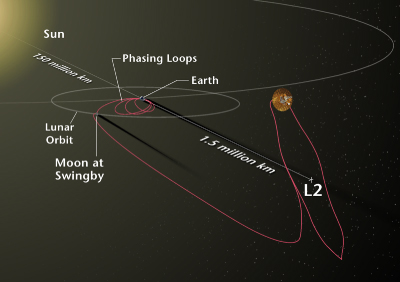Imagine the Universe News - 3 July 2001
MAP Launches Successfully
| 03 July 2001 |

|
|
Kennedy Space Center - Wrapped in billows of smoke and steam, the Boeing Delta II rocket lifts off, carrying the Microwave Anisotropy Probe (MAP) spacecraft. (Click for larger image.) |
The MAP satellite is off and running on its journey to the beginning of time. NASA's Microwave Anisotropy Probe launched successfully on Saturday, June 30, at 3:46 p.m. EDT from Cape Canaveral aboard a Delta II rocket. The satellite will study the first light of the Universe -- the afterglow of the Big Bang -- from an era long before the first stars and galaxies appeared.
MAP will help us understand what occurred in the first few seconds upon creation of the Universe. With this knowledge, scientists can determine the shape, content, history, and the ultimate fate of the Universe.
Will the Universe expand forever? Is 90% of the Universe really made of exotic matter and energy that we cannot detect? MAP will begin to answer these questions.
But first, MAP must undergo a three-month journey to the proper orbit, very far from the Earth to an orbit beyond the moon. The final orbit, called the second Lagrange Point or L2, will be nearly a million miles away from Earth. (In comparison, the Hubble Space Telescope is only about 400 miles away, and the Moon is about 250,000 miles from Earth.)
Before the science instruments even turn on, MAP will circle the Earth three times, spiraling farther and farther away with each pass. On its forth orbit around the Earth, MAP will swing by very close to the Moon and use the Moon's gravity as a slingshot to propel the satellite even farther into space. Then onward to the L2 orbit.
Why L2? The L2 orbit is a place where the gravitational tug of the Earth and the Sun balance out the centripetal force needed for the satellite to rotate around the Sun with the Eath. This allows a spacecraft positioned there to remain relatively stable and fixed in its location with respect to the Earth. So MAP will need very little fuel to maintain this orbit. Also, L2 is far from the glow of the Earth, which therefore provides MAP with a perfect view of the dark sky -- just like getting away from the city lights allows amateur astronomers to see more stars at nighttime. MAP can always point away from the Sun, Earth and Moon to maintain an unobstructed view of deep space.
After three months, MAP gets down to business. Unlike other telescopes, which look at one star and then another, MAP will conduct a blanket survey of the entire Universe in microwave radiation. This is a low-energy form of radiation, light that is less energetic than visible light or infrared.
The Big Bang produced an evenly spread veil of microwave radiation, called the cosmic microwave background. The light first appeared about 400,000 years after the Big Bang, and it still lingers today. MAP will look for tiny temperature fluctuations in this light -- differences that vary only by a millionth of a degree across the veil of radiation that is only a few degrees above absolute zero. The slight temperature differences seen today were produced by slight density differences with the Universe was only a few seconds old.
MAP will take about six months to survey the entire microwave sky. Then it will survey the sky three more times for accuracy over a period of 18 additional months. The MAP team expects to announce its first results, however, after completion and analysis of the second survey, perhaps by the end of 2002.


